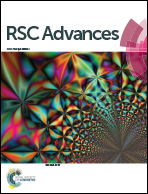Morphology and emission behavior tuning of fluorescent composites using CO2 expanded liquids
Abstract
CO2-expanded liquids (CXLs) were used to develop a promising fluorescent probe, the self-assembled fluorescent composite (SAFC) formed between the dye molecule 4-(9-(2-(4-hydroxyphenyl)ethynyl)-7,10-diphenylfluoranthen-8-yl)-phenol (4) and the diblock copolymer P4VP-b-PS. The change in the solubility exhibited by P4VP-b-PS and 4 with increasing CXL pressure will affect the strength of the hydrogen bonds between P4VP and 4, together with the morphology and fluorescence (FL) performance of the SAFC. The structures and emission behaviors of the SAFC were strongly dependent on the CXL pressure and the molar ratio (R) of 4VP to 4. Meanwhile, the pressure dependence of the emission behavior of SAFC was attributed to hydrogen bonding and confinement acting as the major factors. The maximum FL intensity of SAFC at 5.41 MPa and R = 687 was enhanced by 14-fold in comparison with that of the pristine mixture. This work proves that the CXL method facilitates the modulation of the morphology and emission performance of the SAFC, and opens a new route for the development of efficient luminescent materials.


 Please wait while we load your content...
Please wait while we load your content...